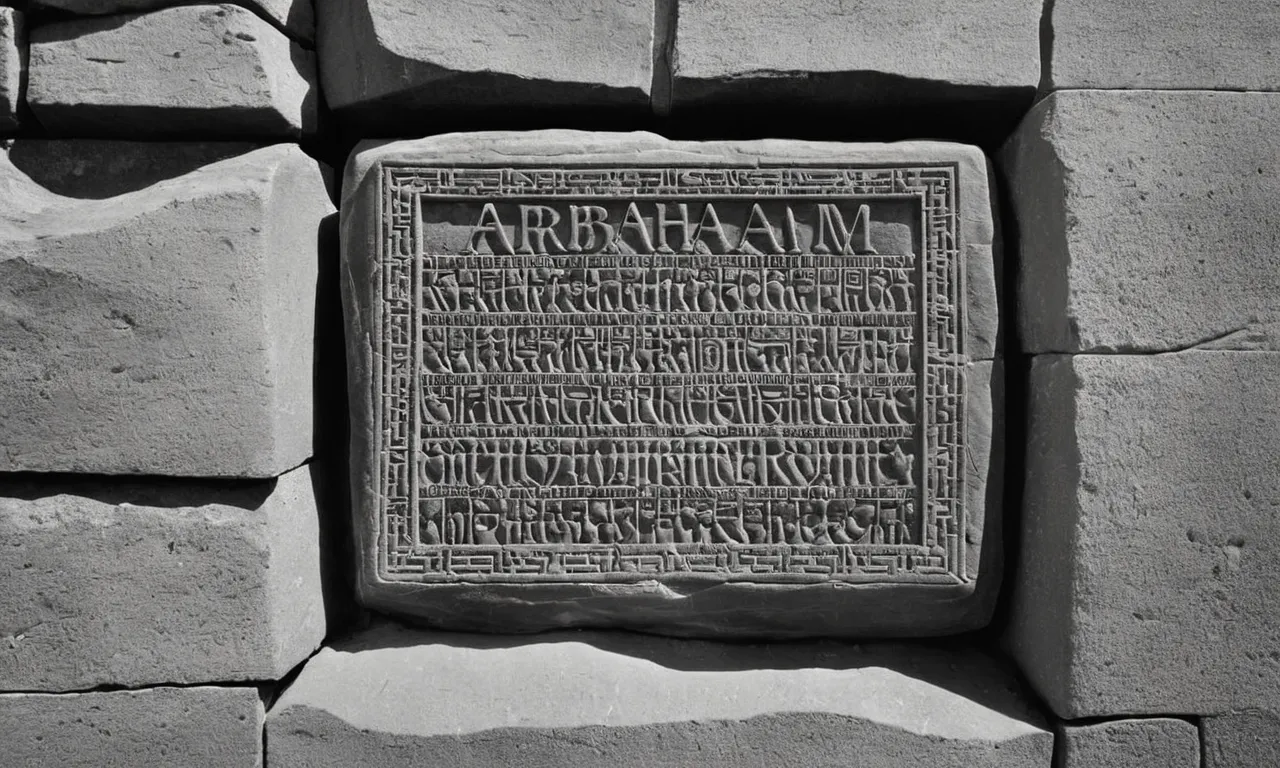When Did Abraham Of The Bible Live?
The biblical figure of Abraham is revered as the father of Judaism, Christianity, and Islam. His story begins in the Book of Genesis when God calls upon him to travel to Canaan and start a new nation.
If you’re looking for a quick answer, most scholars believe Abraham lived sometime between 2,000 BC and 1,500 BC based on contextual clues in the biblical accounts as well as archaeological evidence.
This article will provide a comprehensive overview of the different lines of evidence used to date Abraham’s life, the main theories proposed by scholars, and the continuing mysteries around pinpointing exact dates in the biblical patriarch’s story.
Dating the Biblical Account
References to Other Figures
One way historians date the life of Abraham is by cross-referencing mentions of other historical figures in the biblical account. For example, Genesis 14 describes a war involving Abraham and several kings, including Amraphel king of Shinar and Tidal king of Goiim.
Scholars have linked Amraphel with the famous Hammurabi of Babylon, who lived around the 18th century BCE. While the correlations are not definitive, they provide a plausible timeframe for Abraham’s life.
Real Places Mentioned
The biblical account also contains names of geographical locations that can be tied to actual ancient sites. Abraham’s birthplace of Ur of the Chaldeans, for instance, is widely thought to be the Sumerian city of Ur located in modern-day Iraq.
The route of Abraham’s migration from Ur to Canaan passes through Harran, both of which have been excavated. The mentioning of these verifiable places gives us locations we can associate with Abraham’s journey.
Linguistic Clues
Linguistic analysis of biblical texts also shed light on the probable epoch. The Hebrew of Genesis reflects an older, more archaic style than later books, suggesting an early composition. Loanwords in the text from other ancient Near Eastern languages, like Hurrian and Akkadian, point to origins around the Middle Bronze Age.
So while the dating is not absolute, the combined linguistic clues make an early 2nd millennium BCE date for Abraham quite plausible.
Archaeological Findings
Artifacts in Canaan
Archaeological excavations in Canaan have uncovered evidence of advanced civilization dating back to the early Bronze Age, around 3,000 BCE. Numerous artifacts from this period provide clues about the society that Abraham interacted with when he resided in the land.
Some notable finds include:
- Fortified city walls, gates, and towers – These demonstrate advanced construction techniques and signal the existence of city-states.
- Temples and religious shrines – These indicate organized religion and ritual practices.
- Sophisticated pottery and metalwork – Showing specialization of crafts and artistic expression.
- Administrative texts and seals – Pointing to literacy, bureaucracy, and complex economic systems.
The advanced material culture evidenced aligns with Biblical depictions of Canaan as a thriving region during Abraham’s time. The artifacts provide tangible proof of the civilization which formed the backdrop for many Biblical accounts.
Destruction Layers in Cities
Archaeologists have discovered distinctive burn layers at many Canaanite sites, signaling destructive fires and military conquests. These layers are characterized by collapsed walls and roofs, ash deposits, and weapons such as arrowheads.
They provide clues about widespread turmoil during the Bronze and Iron Ages.
Some key destruction layers matching Biblical events include:
- Jericho – A burn layer dating around 1400 BCE, potentially evidence of the city’s fall to the invading Israelites as described in the Book of Joshua.
- Hazor – A destruction layer from the 13th century BCE, possibly correlating with its fiery demolition by Joshua’s forces.
- Lachish – A thick ash layer from around 1150 BCE indicating its potential conquest by the Philistines as noted in the Books of Joshua and Samuel.
These burn layers testify to the numerous upheavals, battles, and demolitions that marked Canaan during Biblical times. Their timing and locations often align with scriptural accounts, lending credence to the historicity of events described in the Bible.
Proposed Date Ranges for Abraham’s Life
Scholars have proposed a range of possible dates for when the biblical patriarch Abraham may have lived based on different lines of evidence and analysis:
Early Date Range – 2200-2000 BCE
Some scholars believe Abraham lived in the early part of the Middle Bronze Age based on analysis of biblical genealogies, archaeology, and comparisons to other ancient Near East historical sources. According to these estimates, Abraham may have been born between 2200-2000 BCE.
Key arguments for this early date range include:
- Taking the biblical genealogies and chronology at face value points to this period
- Fits the general time period of other ancient Near East accounts and king lists
- There is evidence of migrations, shifting alliances and conflicts among various people groups in this era that could align with biblical accounts
Critics of the early date argue there are difficulties reconciling this range with archaeological evidence and accounting for the numbers in biblical genealogies.
Middle Date Range – 1900-1500 BCE
Many scholars propose Abraham lived sometime during the Middle Bronze Age II or the start of the Late Bronze Age, giving a date range of around 1900-1500 BCE. Reasons for these dates include:
- Better fits archaeological data about settlement patterns, cultures and political dynamics in Canaan
- Aligns with mention of the names of Abraham’s neighbors or contemporaries in other ancient texts
- Allows more time for development of civilizations described in Genesis
Those advocating for a date on the later end argue there is little archaeological evidence for destruction of Canaanite cities that aligns with conquest accounts in Joshua during the 15th-13th centuries BCE.
| Date Range | Key Reasons |
| 2200-2000 BCE | Biblical chronology; Conforms to ancient Near East historical timeline |
| 1900-1500 BCE | Fits archaeological and settlement evidence in Canaan; Aligns with neighboring cultures and ancestors mentioned |
While there are good arguments on multiple sides, many see the period from about 1900-1700 BCE as providing the best fit in reconciling the biblical, archaeological and historical evidence related to Abraham’s life.
But interpretations vary and the debate continues on pinpointing when this pivotal biblical patriarch actually lived.
The Challenge of Biblical Chronology
Determining the precise dates of events described in the Bible has proven to be quite challenging for scholars. Unlike other ancient texts that provide clear references to rulers and events with established dates, the Bible often lacks such definitive time markers.
Additionally, there are gaps and inconsistencies within the biblical accounts themselves that make developing a coherent chronology difficult. However, by carefully analyzing genealogies, cross-referencing kings and rulers, and considering archeological evidence, scholars have proposed estimated date ranges for major biblical events and figures.
One major chronological challenge concerns the date of the Exodus. Biblical passages point to sometime in the 15th century BCE, during the reign of Pharaoh Thutmose III. But references to city names and social conditions suggest a 13th century BCE date, during the reign of Rameses II.
Archeological and textual evidence has not been able to resolve this discrepancy. Proposed dates for the Exodus range across three centuries, from the 15th to 13th centuries BCE.
There is also uncertainty around the chronology of the patriarchs, like Abraham, Isaac, and Jacob. The biblical account provides detailed genealogical data, but translating these into absolute dates is problematic.
Interpretations of patriarchal chronology differ by hundreds of years, from 2100 BCE to 1800 BCE. Resolving the ambiguities in the biblical sources remains an active area of study.
For the periods of the united monarchy and the divided kingdoms, scholars can correlate some biblical kings with rulers known from other ancient Near East sources. For example, the Bible mentions King Shishak of Egypt invading Jerusalem during King Rehoboam’s reign.
Archeological evidence confirms Pharaoh Shoshenq I’s military campaign in Palestine in the 10th century BCE. But many identifications and cross-references remain hypothetical and rely on interpretations of both biblical and extra-biblical evidence.
The date of Jesus’ crucifixion and the chronology of the New Testament period align more closely with established Roman history. But there are still debates around the birth of Jesus. Estimates range from 8 BCE to 4 BCE.
Overall, arriving at precise biblical dates continues to be an elusive quest among scholars.
Conclusion
While there is still uncertainty around Abraham’s exact dates, contextual clues embedded in the biblical accounts and correlated archaeological evidence points to him having lived at some point during the Middle Bronze Age in the 2nd millennium BC.
Ongoing research and analysis of texts and artifacts will hopefully shed more light on pinpointing the elusive lifetime of the towering biblical patriarch. But the powerful legacy of Abraham’s journey of faith continues to inspire Jews, Christians, and Muslims today regardless of the precise century in which he lived.








